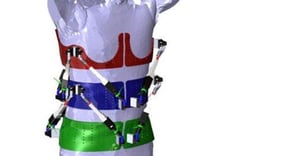Congenital deformities of the spine, like idiopathic scoliosis and pathologic kyphosis, will be able to be corrected in a personalized and more efficient way thanks to a flexible robotic exoskeleton that the bioengineers at the Columbia University School of Engineering and Applied Science in New York, USA, have developed. The new exoskeleton, a type of external shell, is dynamic, adaptable, and soft and can look at in vivo measurements of torso stiffness and characterize its three-dimensional stiffness. In this way patients can be provided with personalized treatment, starting from childhood, if necessary.
As reported in the scientific journal “IEEE Transactions on Neural Systems and Rehabilitation Engineering”, the exoskeleton is made up of three rings, or rather belts, which are positioned around the hips, the lower and the upper torso, and are connected to 12 mini-motors which are inter-connected. These measure the forces and other movements of the spine, and can calculate which type of corrective forces are necessary to “straighten” it.
The robotic exoskeleton, known as RoSE (Robotic Spine Exoskeleton), is a modern and much more sophisticated version of the braces which have been used for at least 50 years on patients with serious spinal curvatures and have remained more or less unchanged in all this time. Due to their inconvenience, as they are rigid, sensor-less, not adaptable to changes in the spine and can also cause damage to the skin, they have always had limited success. The new robotic exoskeleton, on the other hand, will help in creating a new generation of flexible braces and of other more efficient and “portable” remedies.
The RoSE has been tried so far on 10 adults and will be adapted for use with young and teenage girls, as congenital spine deformities are ten times more common in females than in males.

